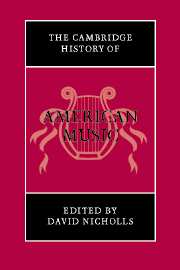Book contents
- Frontmatter
- PART ONE
- PART TWO
- 10 Music in America: an overview (part 2)
- 11 Immigrant, folk, and regional musics in the twentieth century
- 12 Popular song and popular music on stage and film
- 13 The rock and roll era
- 14 Ragtime and early jazz
- 15 Jazz from 1930 to 1960
- 16 Jazz since 1960
- 17 Tonal traditions in art music from 1920 to 1960
- 18 Serialism and complexity
- 19 Avant-garde and experimental music
- 20 Tonal traditions in art music since 1960
- Bibliography and references
- Index
- References
18 - Serialism and complexity
from PART TWO
Published online by Cambridge University Press: 28 March 2008
- Frontmatter
- PART ONE
- PART TWO
- 10 Music in America: an overview (part 2)
- 11 Immigrant, folk, and regional musics in the twentieth century
- 12 Popular song and popular music on stage and film
- 13 The rock and roll era
- 14 Ragtime and early jazz
- 15 Jazz from 1930 to 1960
- 16 Jazz since 1960
- 17 Tonal traditions in art music from 1920 to 1960
- 18 Serialism and complexity
- 19 Avant-garde and experimental music
- 20 Tonal traditions in art music since 1960
- Bibliography and references
- Index
- References
Summary
In the fall of 1961 regular readers of the New York Times would have encountered a pair of brief articles published a day apart which, while unexceptional individually, are striking, at least in retrospect, in their juxtaposition. Thursday, September 7 of that year saw the publication of a short review (Salzman 1961) of a concert sponsored by the Fromm Music Foundation. Presented the previous evening at the Metropolitan Museum of Art under the aegis of the International Musicological Society, which was holding its eighth congress at Columbia University from September 5 to September 12 (with ancillary events at Yale and Princeton Universities and at the Library of Congress in Washington, D.C. [LaRue 1962]), the concert offered only three works. Of these the first two – Vision and Prayer for soprano and synthesized accompaniment, by Milton Babbitt (born 1916), and the Double Concerto, by Elliott Carter (born 1908) – were world premieres, both commissioned by the Fromm Foundation. The third – the Concerto for Violin, Cello, Ten Winds and Percussion by Leon Kirchner (born 1919) – was a New York premiere.
The following day the New York Times printed an unattributed piece (anon. 1961) announcing details of the New York Philharmonic’s new subscription season that was doubtless read with greater anticipation by the majority of readers. According to the article, Leonard Bernstein would frame the season with two special “cycles,” the “Gallic Approach” and the “Teutonic Approach,” occupying the first and last six weeks respectively of the orchestra’s calendar. The French cycle featured not only the works of French composers but also works of “French influenced American composers,” and similarly for the German cycle.
- Type
- Chapter
- Information
- The Cambridge History of American Music , pp. 496 - 516Publisher: Cambridge University PressPrint publication year: 1998
References
- 1
- Cited by

